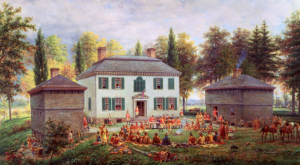
Hayne hudjihini: Eagle of delight,
Credit: Wellcome Library, London.
To tie in with the IHR’s upcoming conference Pocahontas and after: historical culture and transatlantic encounters, 1617-2017, we have gathered a selection of resources from the BBIH that address the themes of Native American women in Colonial America. The women in these resources are portrayed as vital members of their community, who were often pivotal in forging links between the indigenous tribes and the newly-arrived Europeans, while remaining true to their cultural heritage.
“As Potent a Prince as Any Round About Her”: Rethinking Weetamoo of the Pocasset and Native Female Leadership in Early America is an article in the Journal of Women’s History by Gina M. Martino-Trutor. Weetamoo was a female sachem, or chief, who wielded power and influence in the seventeenth century. She was the leader of the Pocasset people, and a primary ally in the Native coalition led by Metacomet (King Philip), head of the Wampanoag Confederacy, to temper the spread of English colonists in New England. Although relations had been largely amicable between the Puritan settlers and the Native Americans in the 1660s, by 1671 the tribes had grown tired of the continual expansion of the colonists, resulting in King Philip’s War (1675-1676). This article explores the role of Native American women in times of war and peace, and assesses their political and military influence in Colonial America.
“The Pocahontas of Georgia”: Mary Musgrove in the American Literary Imagination by Steven C. Hahn in Georgia Historical Quarterly tells a different story, but nonetheless portrays the interwoven yet volatile relations between the colonists and indigenous peoples. Mary Musgrove was born in 1700 and raised by her Creek Indian mother, before being taken away at the age of seven by her English father, a deerskin trader, who subsequently died in the war waged by the Creek Indians against the settlers in South Carolina. Musgrove’s experience and ties to both Native American and English culture put her in a unique position, enabling her to act as go-between as interpretor and negotiator. However, her unsuccessful claims for compensation and land from the Georgian government soured her relationship with the authorities, and resulted in public outbursts of frustration, for which she was arrested twice. This article discusses subsequent depictions of Mary Musgrove in literary texts as she grew in the American imagination, as a savage, vengeful ‘queen’, tragic figure, or feminist, depending on the era, reflecting the complicated relationship America has with its multicultural past, and with gendered biography.

Creek Indians meeting Georgian Trustees. Unfortunately only Mary’s husband, John Musgrove is depicted as translator. Image from Wikipedia

Johnson Hall, Molly Brant’s home from 1763 to 1774. Image from Wikipedia
Following along a similar theme, Molly Brant: Mohawk Loyalist and Diplomat is a monograph by Peggy Dymond Leavey, charting the life of Brant. She became an important intermediary figure in the American Revolutionary War between the British and Iroquois. She was born in 1736 and grew up in a very Anglicized culture, being raised as a Christian Mohawk. She became the consort of Sir William Johnson, British Superintendent of Indian Affairs, and they had a family together. Johnson died in 1774 and as a respected member of the Mohawks, she proved invaluable to the British and was a vital link in keeping the Iroquois onside during the war. Like Mary Musgrove, Molly Brant’s legacy has also waxed and waned throughout history, and although some view her pro-British stance as traitorous, she is honoured as a Person of National Historical Significance in Canada.
Although the relations between the Native American peoples and colonial settlers has often been fraught with difficulties, misunderstandings and deceit, the selection of resources featured above and below demonstrate that there was always a need for relations between the two, with women often forming a pivotal role. A further selection of resources from the BBIH is listed below. For more information on the resources, enter the title on the simple search field, or use the index terms ‘women’ and ‘Native Americans’ to explore further:
‘Cherokee Women Farmers Hold Their Ground’. M. Thomas Hatley
‘In a Red Petticoat : Coosaponakeesa’s Performance of Creek Sovereignty in Colonial Georgia’. Caroline Wigginton
‘“I Wunnatuckquannum, This Is My Hand” : Native Performance in Massachusett Language Indian Deeds’. Stephanie Fitzgerald
Jesus and Pocahontas : Gospel, Mission, and National Myth. Howard A. Snyder
‘Listening to Black Magic Women : The Early Modern Soundscapes of Witch Drama and the New World’. Jennifer Linhart Wood
‘Pauline Johnson-Tekahionwake : Trafficking Woman’. Anne Collett
‘Reading Shanawdithit’s Drawings : Transcultural Texts in the North American Colonial World’. Fiona Polack
‘Senauki : A Forgotten Character in Early Georgia History’. Julie Anne Sweet
The Life and Times of Mary Musgrove. Steven C. Hahn
‘The Transatlantic Pocahontas’. Gary Dyer
‘Translating Values : Mercantilism and the Many “Biographies” of Pocahontas’. Michael Tratner
Further resources available for Pocahontas on BBIH:

